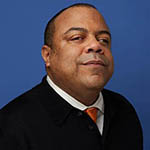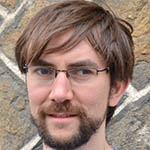Jews, Black Americans, Asian Americans, Latinx and other groups have often been victims
As former police officer Derek Chauvin stands trial for the murder of George Floyd, we approach the one-year anniversary of Floyd’s brutal death that traumatized the nation. The dramatic movement that formed in the aftermath of Floyd’s death has reshaped our national discourse on race and police brutality.
On March 17, Department of Homeland Security Secretary Alejandro Mayorkas declared domestic violent extremism “the greatest threat” to the U.S., with the most lethal threats racially or ethnically motivated.
Extremists participating in the January 6 insurrection at the U.S. Capitol mixed symbols of anti-Black racism like the Confederate flag with insignia of anti-Semitism like the “Camp Auschwitz” sweatshirt worn by one protestor.
Indeed, Jews, Black Americans, Asian Americans, Latinx and other groups have often been victims of the same lethal, white supremacist hatred. At the same time, the last year has been a time of critical conversations about points of convergence and crucial differences in the Black and Jewish experiences in America. While some insist that racism and anti-Semitism must be fought simultaneously as part of a common struggle, others see the two causes as separate or even counterposed.
In this context, what are African Americans’ and Jews’ responsibilities to one another in the country’s current racial reckoning? How might these two communities come together in pursuit of equality? How do race and ethnicity influence opportunities for collaboration? Should they? On April 12, UC Berkeley will host a conversation to address these questions: Race and Responsibility: A Conversation on Black-Jewish Relations and the Fight for Equal Justice.
Berkeley News spoke with several of the experts involved in this event – Ethan Katz, UC Berkeley associate professor of history and Jewish studies, who co-organized the event with Karen Barkey, the Haas Distinguished Chair of Religious Diversity and a professor of sociology at UC Berkeley; the two featured speakers, Michael Rothberg, UCLA professor of English and comparative literature and the 1939 Society Samuel Goetz Chair in Holocaust Studies; and Eric K. Ward, executive director of the Western States Center. Tina Sacks, an assistant professor in UC Berkeley’s School of Social Welfare, will serve as moderator.
Berkeley News: Your upcoming conversation centers on Black and Jewish struggles and examines the interconnected nature of those experiences. Why is this an important conversation to have now? How do these experiences relate to this moment in time?
Eric Ward: This moment should be a wake-up call for all of us. Many have been on a sugar high due to the change in the administration and seeing some stability in the government. Still, we should understand that the dynamics preceding the insurrection on Jan. 6 have not gone away, nor have those individuals.
That is what we saw play out in Atlanta, Georgia. We saw the targeting of vulnerable communities — of women, sex workers, people of color — and we should be clear that regardless of the individual factors, the driver is the idea that these people do not belong in our society and that driver is called white supremacy.
Ethan Katz: Over the past year, we’ve seen the most significant movement for racial justice in this country in my lifetime, probably in half a century. There’s been a lot of conversation in the Jewish community about what this moment should mean. What are white-skinned Ashkenazic Jews’ responsibilities? What can we reasonably ask of African Americans in terms of their understanding of Jews’ historical vulnerability and the danger of anti-Semitism? Last summer I co-wrote a piece published by CNN with Deborah Lipstadt that began to address these topics. In part, I wanted to insist that Jews should be able to draw from their own reservoir of experience to understand how history is deeply embedded in racial injustice. Afterward, Karen Barkey and I decided that we could and should try to go deeper and organize a program on campus that could tackle some of these difficult issues.
Tina Sacks: I think what we’re seeing in the country right now is not really a rise in anything, but rather the surfacing of what is already in existence. We have seen an increase in incidents of violence aimed at Asian Americans, aimed at Jewish people, and Black people, and indigenous people — at so many groups. This just shows the durability of these issues.
How would you describe the historical experiences of the Black and Jewish communities as being both separate and related?
Ethan Katz: Both Jews and African Americans have deep-seated memories of injustice that they carry with them, that are important to each community. Each of us has memories from our own experiences. These experiences historically and currently are of course different in fundamental ways, and yet there are strong parallels that we too often overlook.
Michael Rothberg: For many years, my work has been about how we think about histories that are quite distinct from each other yet often have legacies that intersect; that have origins that are connected in some ways through different forms of racism and colonialism. Without reducing them to the same thing, both Black and Jewish communities have traumatic histories that hold certain similarities, that hold possibilities for solidarity across lines of identity.
Eric Ward: What I have to come to understand is that in the same way that racism drives systems of white supremacy in this country, anti-Semitism drives white nationalism as a social movement. There is a portion of the American public who resist inclusion, reject democratic practice and look for reasons to undercut the work of Black leaders establishing civil rights. One of the ways they do this is by drawing a false wedge, this idea that Black folks are more deeply anti-Semitic or Jewish folks are more racist. It’s a way for society to step away from its responsibilities, a way of confusing behaviors with systems and power. Ultimately, it’s a form of distraction.
Tina Sacks: Anti-Semitism and white nationalism certainly go hand in hand. They are very much intertwined, and when one group is targeted, all other groups are vulnerable. Although anti-Semitism is fundamentally different from the kinds of structural discrimination that Black people and other groups face, our struggles are still intertwined. I insist on recognizing the differences, but solidarity is still the only path forward.
What are your aspirations for outcomes following this conversation? How should communities take action in response to racism and anti-Semitism?
Ethan Katz: Universities should be places where we are talking about the challenging issues of our time. They should be places where we are trying to facilitate difficult conversations among all members of our community. I want this event to be an opening for more talks on campus and more opportunities to organize. But I also hope that parts of the conversation will take people out of their comfort zone in productive ways: in order to tackle fully issues of discrimination and bias, we all need to be having hard conversations within our communities, and events like this can help inspire us to pursue those conversations.
Michael Rothberg: There have been some activist groups of Japanese Americans who became very involved in protests about the internment of migrants from Central America. I think that part of their activism is motivated by a desire not to be complicit in similar forms of violence that are happening in the present, which they recognized from their own histories in the past. Similarly, I am interested in not just the forms of solidarity that bring Black and Jewish people together, but rather how we might reach out beyond the boundaries of a particular group.
Tina Sacks: There’s an organizer named Mariame Kaba, she’s a prison abolitionist and a community organizer. One of her famous quotes is “hope is a discipline.” I really like that idea because although we obviously have so far to go — this is a problem that’s been with us since human history began and it will probably be here for a while — the fight continues. We have to imagine a world that’s different and we have to imagine the world we want. To do this work, we have to believe that there is a better way forward, even in the face of what we see every day.
Eric Ward: We have to understand that at this moment, we have to fight the fear together. There is no solution to this problem that does not come from communities uniting across lines of color, gender, race and class. We are truly all in this together. So, engagement will look different for each and every person. For some, this will mean focusing on laws, rules and regulations. For others, it will be researching and bringing to light a better understanding of these movements. What I hope is that everyone walks out of this conversation thinking about the one thing that they can do to make a difference. Not everybody has to do it all, but all of us have to do one thing.









0 Comments
please do not spam link